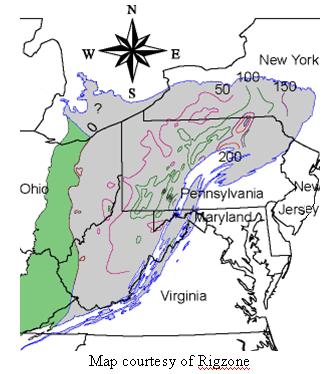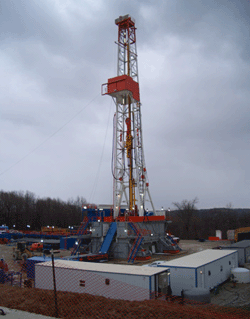Marcellus shale
From Wikimarcellus
The Marcellus shale formation is a marine-sedimentary, rich-organic layer of black-shale rock. It is found deep underground in an area covering approximately 65,000 square miles and stretching roughly 600 miles from southwestern New York to West Virginia and includes parts of Maryland, Kentucky, Ohio and Virginia. It is very high-quality source rock. The thickest portion of it is located in northeastern Pennsylvania and south central New York with a thickness of up to 250 feet or more. The main area of the formation is around 18 million acres. It is named for an outcropping near Marcellus, N.Y.
Gas in the formation is found trapped in natural pores and fractures of the rock so tight that it is released only very slowly or else the gas tightly adheres to the rock. Both conditions may be true. It has been accumulating in the shale due to breakdown of high levels of organic carbon or kerogen. Temperature, high pressure and time are all factors in its development.
The Marcellus shale has three main sub-divisions:
- Cherry Valley Limestone (differently named in various locations)
- Oatka Creek Shale
- Union Springs Shale
These layers of rock have different organic contents as well as their own separate thickness characteristics due to the way in which the shale was originally deposited and over time eroded.
It has been known for decades that this layer contained natural gas, but until recently it was not believed economical to extract. Recent improvements in technology such as horizontal drilling and hydraulic fracturing of the shale have somewhat changed its economics. When these developments were combined with the comparatively high prices of natural gas during the first half of 2008 this endeavor appeared profitable for all of its participants. Earning a reasonable return on investment may now prove more elusive since natural gas prices dipped under US $8 per Mmbtu for most of the second half of 2008, and were under $5 for much of 2009 and the first half of 2010.
Recent estimates have ranged from between 50 and 500 trillion cubic feet (Tcf) of natural gas that could be produced from Marcellus shale. As more and more favorable drilling results become available to benchmark estimates, forecasters have grown increasingly confident about making projections closer to the high end of this range. 500 Tcf would be enough gas to supply the entire U.S. for about twenty years at the present rate of consumption.
In some areas of the formation, natural gas fractions are also present such as butane, ethane, and propane.
Pennsylvania has around one half of the proven U.S. natural gas reserves. The proximity of most of the deposits to the natural gas consuming cities of the east coast makes the Marcellus an especially attractive target for exploration.
The Marcellus shale formation is usually found at a depth of 5,000 to 8,000 feet, but can run as deep as 9,000 feet. Pressure gradients range between .40 to .58 psi.
Marcellus shale drilling rigs are roughly twice the size of ones used for shallow wells. They are usually around 150 feet high, with an equipment platform 20 feet off the ground. Horizontal drilling rigs are bigger still requiring larger horsepower engines to drive the drill bits further along.
The production of a typical shale gas well drops off significantly after the initial year or two and then slowly declines after that over its full lifetime.
In the industry, it is known as an “unconventional deposit.”
One method of prospecting for gas, not only in shale formations but also for gas found within deeper structures below, is to use seismic waves to map out the underground location of deposits.
Exploration typically begins with vertical wells. If natural gas is found in commercial quantities and grade then the initial production can help fund later horizontal drilling.
When gas shows are spotted in traditional source rocks then it merits further investigation. This may consist of reviewing existing data from the well, examining core samples and analyzing other information.
If the results of the preliminary investigation look promising then vertical wells are drilled to locate the most prospective part of the formation and confirm the characteristics of the reservoir. Analysis of seismic data also plays a role.
If all looks good, then horizontal drilling may be undertaken.
A horizontal well bore has the benefit of intersecting more of the shale and producing far greater amounts gas once it is hydro-fractured.
Companies operating in the Marcellus shale area have generally benefited from improved drilling and completion techniques as they have gained more experience in the play. They have been targeting the more brittle parts of the shale formation that provide the richest organic material. These are the best places to frac. As learning curve economics begins to work more in the drilling companies favor, it has opened up a greater range of geography for development as the drillers have gained greater confidence in their operations.
Resources
-Wikipedia.org on Marcellus Formation
-American Petroleum Institute video on Horizontal drilling And Hydraulic Fracturing
The Utica shale formation ranges between 300 and 1,000 feet thick. It is an Upper Ordovician black to gray-black shale that is 440 to 460 million years old. It is considerably deeper than the Marcellus shale which is part of the Middle Devonian formation. It is immediately below the Lorraine shale formation. Utica shale is a porous, thick, brittle, over-pressured and thermally mature source rock. These factors are very conducive to artificial fracture stimulation.
Utica shale was deposited very widely across the Appalachian Basin and into Ontario. It covers several thousand square miles and generally trends north-south.
The Flat Creek Member forms the base of the Utica shale, and it rests discontinuously on the Trenton formation. The middle member is the Dolgeville, and the top one is the Indian Castle. Each shale interval has its own unique geological makeup.
The commercial Utica shale play is located in the Saint Lawrence Lowlands of Quebec, Canada, and in central New York especially in Chenango, Delaware, Herkimer, Oneida and Otsego Counties. The Canadian and U.S. parts of the play are separated by the Adirondack dome. Utica shale (aka Collingwood shale) also underlies much of the northern Lower Peninsula of Michigan, but is virtually undeveloped there with the exception of one well drilled in Missaukee County, MI during the winter of 2010. There also has been some very limited exploration of the Collingwood (Utica) shale in southwestern Ontario, Canada. During 2010, several companies were investigating Ohio, especially the eastern half of the state, as an area prospective for natural gas from the Utica shale formation.
In fact, the Utica shale formation as a whole is relatively underdeveloped, so the quantity of natural gas it holds as well as commercial viability are difficult to assess given so little drilling experience. However, there has been some apparent success in drilling the Utica shale formation in the Saint Lawrence Lowlands, Province of Quebec, Canada. Should commercial quantities of Utica shale gas also be verified in New York, Pennsylvania and West Virginia, the formation could be developed with minimum cost and environmental side effects since the necessary infrastructure has already been put in place to develop the Marcellus shale.



